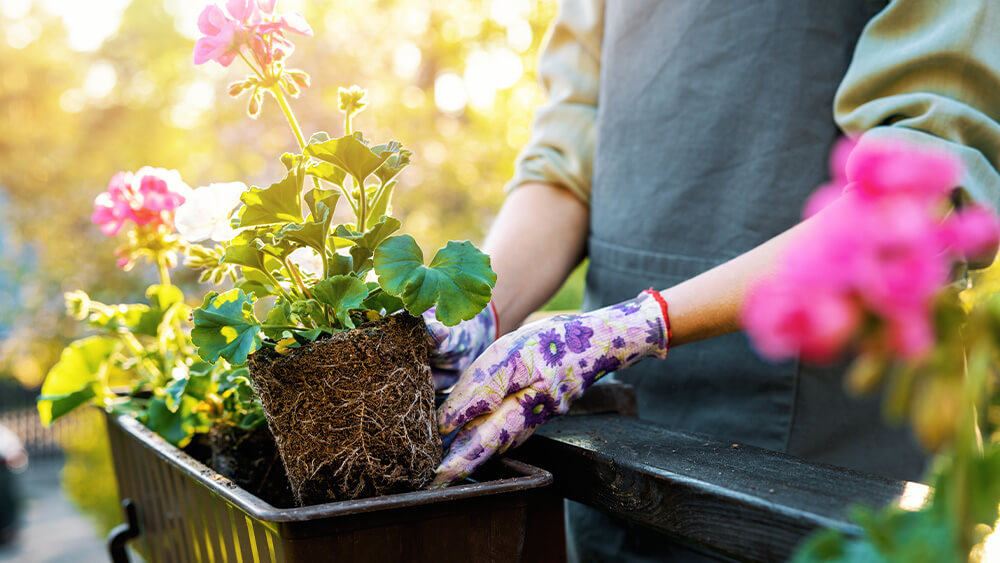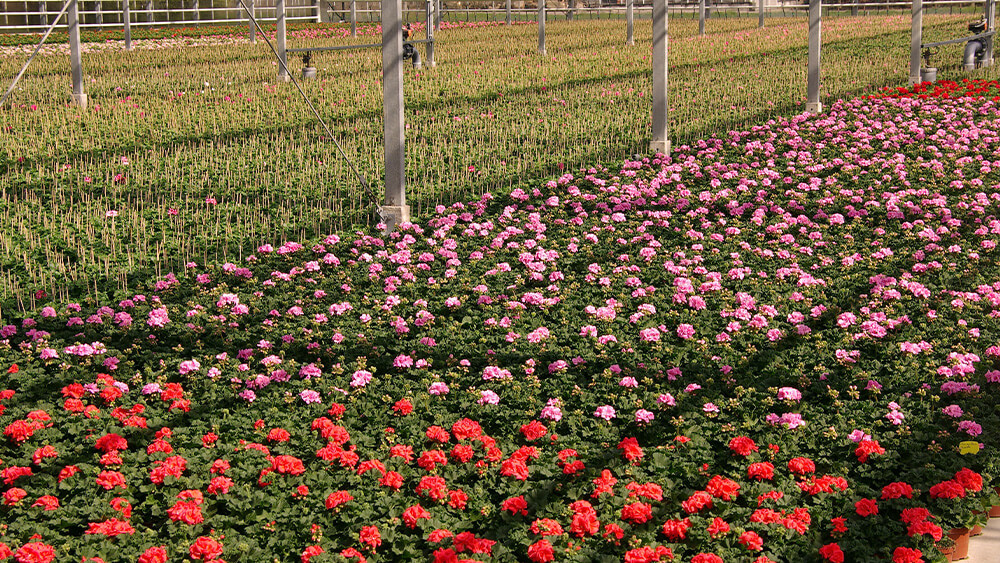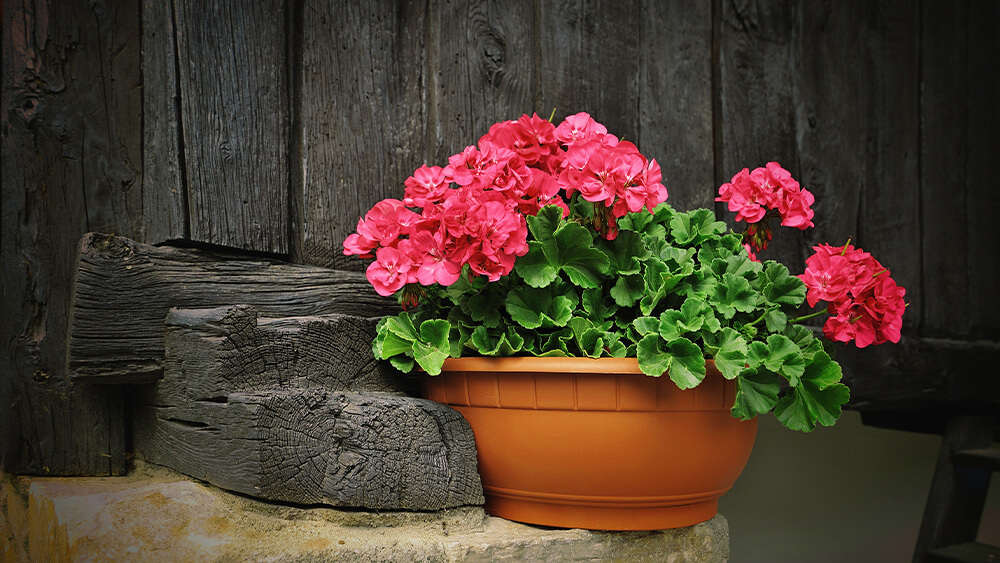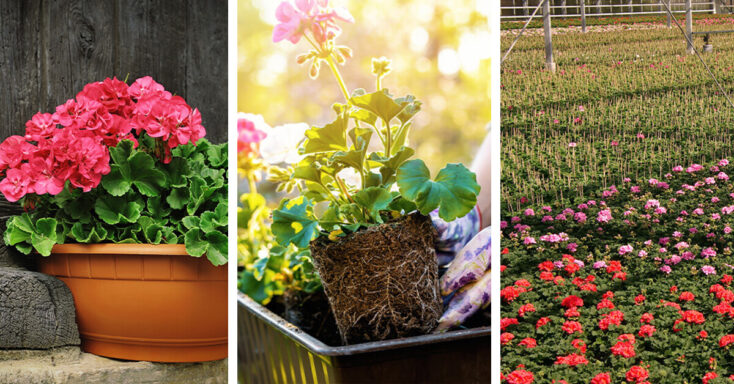Geraniums are a well-admired flower as an ideal ornamental plant for gardening and landscaping. In fact, selling geraniums is a billion-dollar industry. They come in seemingly every color of the rainbow and sizes, one of which should match your outdoor plans. Put them in containers you can move around. Plant them along paths and entryways. With proper geranium care, you can have some fun all summer long!
Key Takeaways
- Geraniums don’t require a lot of water or fertilizer, making them easy to care for.
- It’s easy to find a geranium that fits in with your landscape or gardening plans.
- This flower is a great choice for novice gardeners.
- Geraniums are edible and have various medicinal uses.
Glorious Geraniums
The Geranium genus has 422 species. Some are annuals. Others are biennial or perennial. You’ll find Geraniums throughout temperate regions. The name Geranium comes from a Greek word that translates as crane. The nickname “cranes bill” remains because the fruit capsule in some cultivars looks like a crane’s head and a beak formed from the stigmas.
Geraniums are often mistaken for pelargonium. When the Dutch brought the flowers to Europe (via South Africa), their resemblance created confusion. The new plant (Pelargonium) looked like hardy wild geraniums dotting the European landscape. Botanists grouped them together for many years.
Elevated Geranium: In the UK, geraniums appear regularly on balconies. This is true in Europe and Switzerland, too. And the mezzanine won as the perfect place for these flowers. In Switzerland, Geranium is the national flower.
Outdoor Geranium Care
There are a few things to remember in geranium plant care. When you place them in the ground, put light mulch over the soil. This cools the roots. Speaking of soil, it should dry between waterings. Over-watering is an enormous problem in growing geraniums. If you put your finger in the ground one inch, and the soil is dry, it’s time to water.
When adding water to your geraniums, always do it at the base of the plant. The leaves are sensitive to water. Damaged foliage can develop diseases.
As you are tending geraniums, look for dead blossoms. Take those off. Pinch it gently, and the plant rewards you with re-blooming. Similarly, pinch back leggy stems. It promotes bushiness.
Finally, if you have outdoor potted geraniums, repot them in spring. This refreshes the plant and energizes growth.
Geranium lovers in many parts of the world participate in annual shows and conventions. Attendees may enter their plant for recognition. Categories include best aroma, best fancy, and best dwarf, just to name a few. The shows may also have themes like drought-tolerant plants. Depending on the location, there may be tours where folk come and simply enjoy the diversity before them. Seed exchanges or sales are common.
The Needs of Outdoor Geraniums

Geraniums require about 5 hours of sun daily, more if it’s in a shaded area. If there’s a spot in your garden that receives morning light and afternoon shade, you’ll have thrilled flowers. If necessary, amend your soil with commercial blends focused on proper draining. Moist soil is fine, wet is not.
If you live in a four-season environment, you can put your geraniums in pots. The plants suffer when the temperatures are below 55F. So, when frost threatens, you can move the plants to a safe location like a garage or mud room. While inside, the flowers will die off and hibernate until spring. During this period, only water twice a week.
When you plant the geraniums, don’t crowd them. They need air circulation and root space. Keeping them separate helps deter the spread of insects and diseases, too. If you have perennials, practice crop rotation, and soil amendment annually.
For fertilizer, geraniums benefit from 200 pm of nitrogen. A 15-15-15, 15-16-17, or 20-10-20 blend works well. It minimized nutrient problems.
Edible Geraniums: Geraniums are one of many edible flowers used in cooking and baking. They enhance flavor, offer aroma, and make for great plating. Depending on the plant, you may find lemon, rose, or mint notes.
Feeling adventurous? Gather three rose-scented geranium leaves along with three peppermint-scented ones. You also need three cloves, two black tea bags, and a sweetener (to taste). Boil ½ point of water and pour it over the ingredients. Let them infuse for five minutes. Strain. Enjoy with sweetener hot, or serve it over ice.
Geranium Selection
When you start shopping for geraniums, it may feel overwhelming. A catalog review will over-fill your head. So, let’s narrow the field by looking at a few.
Ann Folkard: Ann grows to 20 inches tall. The leaves of this geranium are vivid green. Flowers have a black eye with stunning flowers veined in place.
Ballerina: The ballerina is cheerful as she dances along the ground. This cranesbill develops a flowing carpet of pale green. In Summer, blush pink flowers appear with purple veins and eyes. Plant it with your irises.
Biokovo: If you want aromatic geraniums, the Biokovo is a good choice. It’s a hardy plant, developing ground cover in pale green. In Spring and summer, pastel pink flowers lift their heads above the foliage, having dark eyes. If your area is limited, this is a dwarf shrub.
Blugold: Also called Blue Sunrise, Blugold is a fantastic selection for growing in containers. Baby blugold leaves are yellowish with hints of orange. This foliage makes an impressive backdrop for lavender flowers.
Brookside: Brookside fits in with cottage gardens. The mature plant is 18-24 inches. Brookside’s flowers are nearly see-through in the sunlight—color: sapphire blue petals dotted with white centers.
Maculatum: Consider maculatum as border flowers. They reach a mature height of about 25 inches. Maculatum attracts pollinators, creating a natural theme park in your yard. Blossoms from late spring to early summer.
Mavis Simpson: If you have a south-facing spot in your landscape, plant Mavis Simpson there. The plant grows to 8 inches tall. The flowers are a pretty rose-silver pink. They’re very fetching against gray foliage.
New Hampshire Purple: Mature height of 8 inches. Tiny, tight leaves turn reddish in fall. During spring and midsummer, it erupts in magentive flowers, facing upward to the sun. This makes strong ground cover.
Palmatum: A stunning geranium, this is a dynamic plant with deep green foliage. Palmatum is packed full of pink flowers darkening to magenta in the throat. Mature height 3-4 feet.
Renardii: A summer-flowering geranium measuring 14-16 inches. Renardii is a hardy, dense ground cover with white blossoms tinted in stripes of blue-purple appearing in late spring. The foliage is basil-green
Rozanne: A geranium with prolific blue 2-inch flowers starting in early summer. The leaves cut a refined profile in marbled green. They turn slightly rust color in autumn.
Silver Queen looks lovely with English roses. Silver Queen produces pretty cranesbill flowers one inch in height, nearly an iridescent white (sometimes pink with lavender tones). They grow 10 inches tall and flow nicely over a stone boundary.
White-Ness: An aromatic geranium with dainty white blooms in late spring. It’s hardy, not overly picky about its soil. White-Ness is shade tolerant and grows to 12 inches tall.
In South Africa, healers use geraniums to treat respiratory problems. Roots, in particular, appear in cold remedies. Some species of Geranium can calm a person, reducing stress.
Watering Techniques for Geranium
There are some “tricks” to watering geraniums. First, create a consistent schedule for your plant. Pay attention to how long it is between watering and dry soil. When it’s time to water, keep your hose near the base of the plant. Adjust your schedule based on periods of high heat. When cool months come, reduce watering.
Whether from rain or a hose, geraniums need an inch of water weekly. Keep mulch around your plant to help moderate moisture. Never let the plant completely dry out or completely stay wet.

What’s Bugging You? Scented geraniums are like bug spray. They repel a lot of annoying insects. So, while you’re enjoying the lovely aroma floating on the winds, you’re in good hands for deterring mosquitos and wasps. Look to orange or lemon-scented geraniums for the best results.
Potting and Repotting Outdoor Geranium
Geraniums take well to container gardening. The beauty of planting in pots is you can move them around your landscape on a whim.
When you first bring home the plant, use a container that’s slightly larger than the garden store housing. Build with basic potting mix and some plant fertilizer. Your local nursery may have a mix specially blended for Geraniums, so ask.
Every 2-3 years, they’ll need a slightly larger growing space toward the end of winter or early spring. Look for roots peeking out of the top of the soil or through the drainage holes as a sign. Buy a container one to two inches in diameter larger than the current one. Always remember to get containers with good drainage holes.
Lay out some paper to avoid a mess. Put the geranium pot on its side. Grasp the bottom of the stem with one hand while holding the pot with the other. Pull gently, wiggling a little to release the roots.
Prune roots twisted or matted around the root ball. Also, clean off anything that looks mushy or dead. Fill the new container with 3 inches of soil. Place the geranium into the middle of the pot, securing the base with soil on each side. Press the soil down on all sides.
Soak the pot with water until it runs out of the drain holes. Move the plant to where you wish in your lawn and continue with normal geranium care.
Some geraniums go overboard by growing to record-breaking sizes. Can you imagine a 16-foot-tall geranium with double that size in girth? These types of plants make a choice for “step down” landscaping (like placing them next to a larger tree).
Geranium Care: Pruning and Maintenance
One part of geranium maintenance is dead-heading. Without removing spent blooms, the plant becomes sparse. Eventually, it will stop blossoming. Any time you see brown or weak flowers, pinch them off on the stem just below a node. That spot is where new growth begins.
If you have a bushy plant, work through it a section at a time pruning off dying flowers. Revisit pruning every two weeks. You can also get rid of dry, fading stems.
When the blooming season is over, you have the opportunity to shape your plant as you wish. The plant benefits from this, too. The Geranium can direct energy into stronger roots for the coming spring.
The Nose Knows: If you love the aroma of flowers, there are several geraniums that have stronger scents than others:
- Angel’s Perfume: Lemony
- Apple: Apple with citrus notes
- Apricot: Sweet and fruity
- Attar of Roses: Strong rose fragrance
- Cedar: Woodsy, cedar
- Cinnamon: Distinctly cinnamon
- Citronella: Alternatively called citrus geranium; lemony
- Dr. Livingstone: Rosy lemon
- Lady Plymouth: Woodsy rose
- Lime: Tiny flowers with huge lime impact
- Mrs. Taylor: Musky
- Nutmeg: The Old Spice of the flower world
- Peppermint (mint geranium): Muddled mint
- Strawberry: Sweet and fruity

Blooming and Resting Periods for Outdoor Geranium
In areas receiving frost, geraniums will need a safe place to live. A cool, dark garage or cellar are two examples. Cut the stems back to about 6” above the soil. The best temperature in winter is about 50F. New growth appears in spring. Cut off any old leaves and put them back outside.
The Geranium is an emblem of joy, health, friendships, and positive intentions between people. It portends celebratory occasions and happy thoughts. The symbolism for geraniums changes slightly depending on the color. Blue geraniums represent peace of mind. Pink embodies love and purple sends the message of recognition. Red blossoms are protective, and white supports fertility. Yellow expresses friendship.
Outdoor Geranium Common Pests & Plant Diseases
As an outdoor plant, your geranium’s health depends on staying clear of pests and diseases. So whenever you’re garding take notes about any changes you notice. Are buds wilting? Are the leaves browning or fallilng quickly? Both indicate potential pest infestations.
Some of the common insects attracted to geraniums include mites, flies, lacewings, ants, and aphids. If you can introduce ladybugs to your garden, they’ll help keep pests under control. Other beneficial predators include ground beetles, toads, lizards, and frogs.
When you have larger infestations, spray them with insecticidal soap or Neem oil every other day until signs of the bugs subsist.
Diseases
Leaf Spot: appears on your plant on the underside of leaves, looking much like water spots. The disease starts on the lower leaves slowly moving upward. One way to avoid this is to keep water away from geranium leaves. Leaf Spot requires copper-based fungicide.
Boytrytis Blight: a fungus that appears on flowers first. This means you have a chance of catching it quickly. Until you resolve the issue, your geraniums aren’t going to look very pretty.
Snip off affected areas of the plant. If the flowers are too crowded, separate them for better air circulation. A couple of weeks of Neem treatment can help.
Root Rot: Usually caused by over-watering. The roots effectively drown and die. Adjust your watering schedule. Trim off dead or dying parts of the root ball and re-pot.
A story claims the geranium grew where Mohammed hung his shirt to dry in the sunshine. In Norse mythology, Geraniums are sacred to Odin, the god of wisdom and poetry. In this region, it earned the name “Odin’s favor.”
Troubleshooting Common Outdoor Geranium Problems
- Plant turning reddish: The plant is too cold. Move it to a place getting more sun.
- Spindly plants: Low light conditions. The plant seeks the sun. Adjust placement.
- Unopened dropping buds: over-watering.
- Lower leaves with yellow edges: nutritional problems. Get a soil test.
Geranium flowers appear in love spells. Geranium root was used in amulets for protection. The wise person would rub rose geranium leaves on windows to secure a home from any unwanted intrusion.
Frequently Asked Questions About Geraniums Plants Care and Keeping
Do geraniums like sun or shade?
If geraniums aren’t blooming they might be lacking light. Fewer flowers = not enough light. They’re the sun-loving type requiring 4-6 hours of light daily. Putting them on the southern or western parts of your lawn supports their growth.
How do you take care of potted geraniums?
Absolutely. Geraniums take to container gardening without issue. You can start your plants in pots anywhere outdoors you wish. If you have them in containers, you can move them indoors in winter.
Do geraniums like the sun and water?
Yes and no respectively. The balance of requirements boils down to geraniums needing more sun than water. The full sun feeds geranium blossoms. Too much water drowns your plant.
How do you keep potted geraniums blooming?
Cut back dead blossoms when you notice them. Make sure the geranium has enough sun (6-8 hours a day) and avoid too much water.
How long do potted geraniums last?
On average, geraniums live for about two years, but with proper care, they can last much longer.
What is the secret to healthy geraniums?
Pay attention to the amount of water and sunlight. Make sure your plants have proper drainage. And, if you live in an area with harsh winters make sure you plan a safe space to protect your geraniums until the next season.
Summary
Geraniums not only look good, but they smell divine. It’s easy to grow and care for outdoor geraniums and mix them into your landscape with ease. There’s a geranium in the world for everyone!


